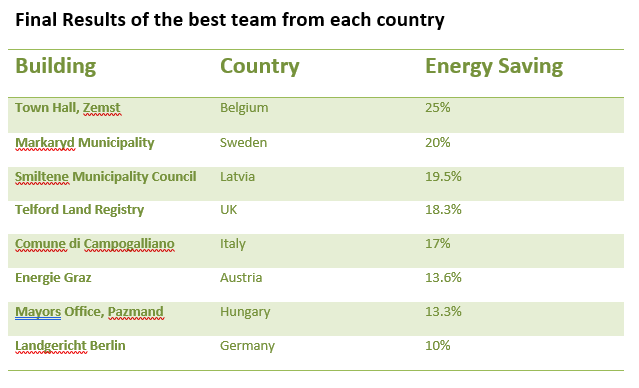
Energy Teams across Europe really can save@work
Public Sector employees make fantastic energy savings
How much energy can a building save with a little help from the employee’s? Quite a lot it would seem!
Teams from 8 European countries came together in Brussels during European Sustainable Energy Week to discover which of them managed to save the most energy following a year-long behaviour change, energy saving competition for public sector employee’s.

The save@work project which took place in Austria, Belgium, France, Germany, Hungary, Italy, Latvia, Sweden and the UK, has been supporting teams of employee’s in 176 public sector buildings to save energy using simple behaviour change techniques and experiencing extraordinary results.
The winning teams managed to save between 10% - 25% of their average yearly energy consumption, making significant impacts on both their carbon emissions and the financial costs of running their buildings. Collectively, the 176 buildings managed to save in excess of 4 million kWh, nearly 1,800 tonnes of CO2 making a cost saving of around half a million euros.
Talking at the event, which was held at the Permanent Representation of Sweden to the EU, Truls Borgström, Energy Counsellor said ”The save@work project is interesting because it shows that it is possible to reduce the energy consumption a lot with simple measures that don’t require investment”.
By identifying how energy is used in the office, the energy team for each building simply focussed on making small changes to their energy consuming behaviours and used a huge variety of techniques to encourage their colleagues to do the same! The overall winning team, the Town Hall at Zemst, Belgium, managed an extraordinary saving of 25%.
The winning teams from each of the participating countries were awarded certificates by Vincent Berrutto, Head of EASME’s Energy Unit who said that “the public sector has a key role to play in the achievement of the EU’s 2030 climate and energy targets. Projects like save@work not only brings economic and environmental benefits but also positive interactions between employees“
Final Results of the best team from each country





 © 2018 ICTFOOTPRINT.eu – ICTFOOTPRINT.eu has received funding from the European Commission’s Horizon 2020 research and innovation programme under the Grant Agreement no 690911. The content of this website does not represent the opinion of the European Commission, and the European Commission is not responsible for any use that might be made of such content.
© 2018 ICTFOOTPRINT.eu – ICTFOOTPRINT.eu has received funding from the European Commission’s Horizon 2020 research and innovation programme under the Grant Agreement no 690911. The content of this website does not represent the opinion of the European Commission, and the European Commission is not responsible for any use that might be made of such content.